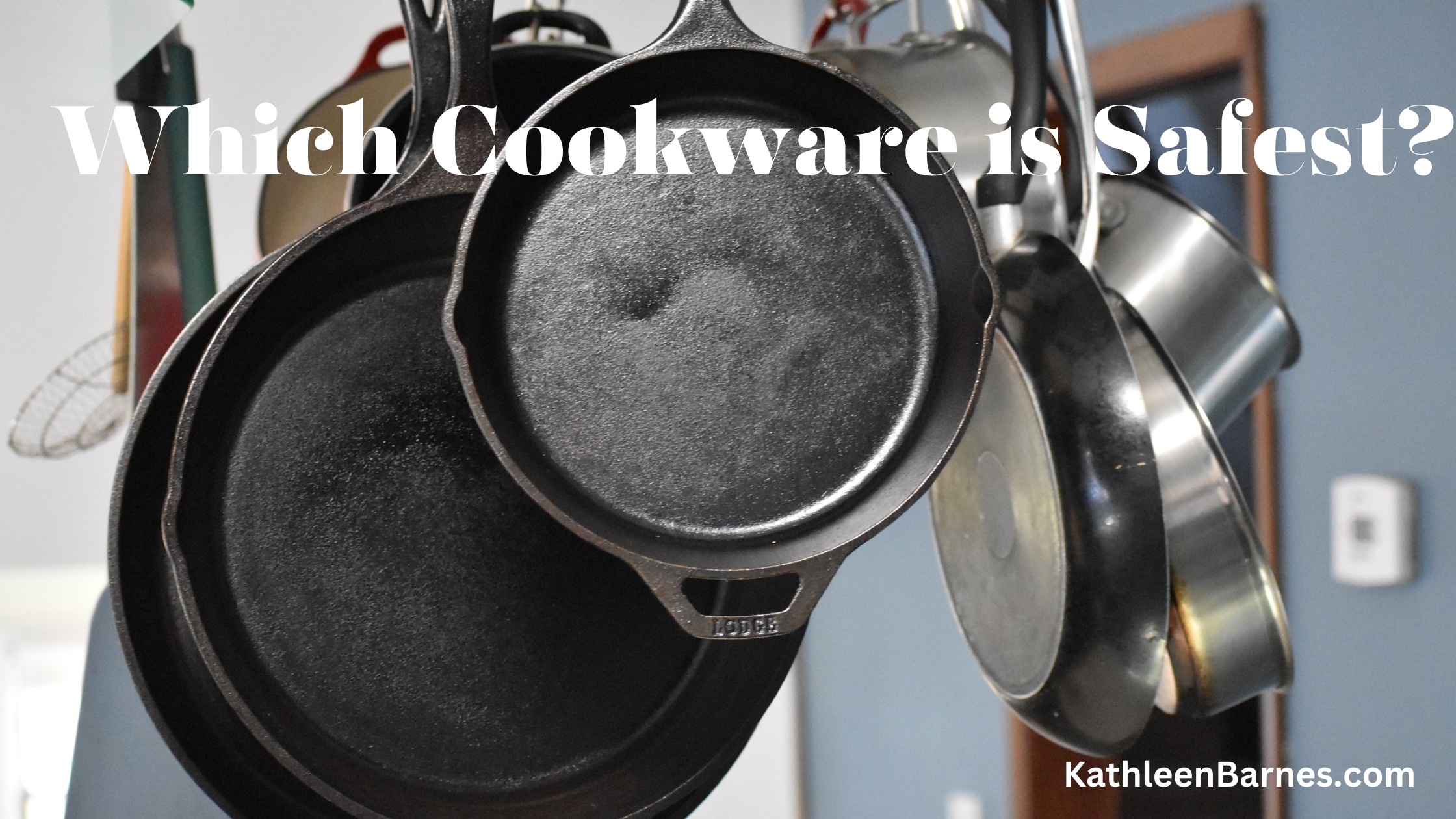The kitchen is the center of any house. It’s here that meals are not only made, but also memories are created, flavors are discovered, and wellness journeys begin.
are discovered, and wellness journeys begin.
The cookware we use is an often-overlooked yet vital component of culinary art and wellness, especially amidst the fragrances of sizzling spices and boiling sauces.
The selection of pots and pans has a significant impact on our health and the quality of the food we eat, and it goes beyond simple convenience or beauty.
Why is using safe cookware so important?
Understanding how cookware affects our meals can help us find the solution. Certain materials have the ability to slowly affect our health by releasing chemicals or metals into the food we eat.
The correct cookware can improve the nutritional content of our food while preserving its nutritional integrity. Additionally, the flavor and success of our culinary activities are strongly impacted by the quality of our cookware.
A well-selected pan can even affect the dish’s texture and flavor in addition to ensuring even cooking and preventing food from sticking.
With this comprehensive guide, we’re going to take a journey around the world of safe cookware. We’ll look at the minor variations between the following kinds: carbon steel, cast iron, glass, stainless steel, and steel coated with ceramic.
Each of these materials has unique properties, from the resilience and adaptability of stainless steel to the natural non-stick properties of seasoned cast iron.
As we go through each variety, you’ll learn why they’re better options, how to maintain and care for them, and what applications they have in your kitchen.
Knowing how your cookware selections affect your meals and your whole kitchen experience will help you create healthier, more delicious meals whether you’re a seasoned chef or a home cook.
Now let’s flip the page and dive into the realm of wise and safe cookware selections!
In A Hurry? Here’s Your Safe Cookware Comparison
Here’s a table that compares the different cookware types based on health benefits, cost, maintenance, and best uses:
|
Feature/Cookware Type |
Stainless Steel |
Cast Iron |
Carbon Steel |
Ceramic-Coated |
Glass |
| Health Benefits | Non-reactive, no chemical leaching | Adds iron, no synthetic coatings | Adds iron, chemical-free | Free from PFOA/PTFE, non-toxic | Chemically inert, no contamination |
| Average Cost | Mid to high range | Affordable, great long-term value | Generally affordable, mid-range | Mid-range, varies with quality | More affordable compared to metal cookware |
| Maintenance | Dishwasher safe, easy to maintain | Requires seasoning, not dishwasher-safe | Requires seasoning, hand wash only | Hand wash recommended, avoid metal utensils | Dishwasher safe, handle with care to avoid breakage |
| Best Uses in Cooking | Versatile, ideal for browning and searing | Perfect for high-heat cooking, oven-safe | Ideal for quick cooking, like stir-frying | Great for low-fat cooking, delicate dishes | Best for baking, roasting, and food storage |
Prioritize your health and cooking style when choosing the appropriate cookware.
- For Versatile Cooking: Stainless steel is a sturdy and adaptable option if you need cookware for a range of cooking techniques.
- For Iron Enrichment: For people who wish to boost their intake of iron through diet, carbon steel and cast iron are great options. They work well for searing and high-heat cooking.
- For Health-Conscious Cooking: Ceramic-coated cookware is an excellent option if reducing chemical exposure is a top concern. It works especially well for delicate meals and cooking on low to medium heat.
- For Safe and Economical Cooking: Glass cookware is the most affordable option and provides an entirely inert surface, making it ideal for roasting and baking. Be sure to check the safety information on how to use your glass cookware properly.
Your choice should align with your typical kitchen activities, health concerns, and maintenance preferences. A mix of different types might be the best approach to cover all cooking needs and preferences.
Reddit has a community called Buy It For Life where you can get information on cookware that has worked well for others. Try different search terms to find exactly what you’re looking for.
Stainless Steel Cookware – The Reliable Choice for Healthy and Versatile Cooking
Health Benefits
Cookware made of stainless steel is distinguished by its non-reactive quality, which guarantees that your food will stay pure and uncontaminated.
Regardless of how acidic or alkaline the food being cooked is, it does not absorb chemicals or metals into your meals like certain other materials do.
Stainless steel is a great option for health-conscious cooks who are concerned about maintaining the nutritional integrity of their ingredients because of this inert property.
Cooking Tips
One common challenge with stainless steel is preventing food from sticking. The key is in the heat management and the use of oil.
Start by heating the pan before adding oil – a process known as preheating. Once the pan is sufficiently hot (a sprinkle of water should dance on the surface), add your oil, ensuring it coats the bottom.
This method creates a temporary non-stick surface. Sit your food out and let it get to room temperature for a more even sear and reduced sticking.
Average Cost
The cost of stainless steel cookware can vary greatly, and is typically determined by elements such as thickness, brand reputation, and the type of core used (copper or aluminum for optimal heat dispersion).
High-end collections can cost several hundred dollars, while basic sets can be purchased for as little as $50. To strike a balance between price, quality, and durability, go for a mid-range set.
Maintenance and Cleaning
Stainless steel is beautiful because it’s so simple to keep clean. Although hand washing is advised to preserve the sheen of stainless steel cookware, the majority of it is dishwasher safe.
Warm, soapy water and a sponge are all you need for daily cleaning. Use a non-abrasive cleanser or a vinegar and water mixture to remove more stubborn stains or discolorations.
Bar Keepers Friend is a well-liked option for giving stainless steel kitchenware their original shine back.
Best Uses in Cooking
Cookware made of stainless steel is truly strong because of its versatility. It works great with practically any cooking technique. Because of its excellent heat retention and equal distribution, it works especially well for browning and searing foods.
It’s also perfect for boiling pasta or veggies and simmering sauces. Because stainless steel is non-reactive, you can cook acidic items like tomato sauce without fear.
Kitchens all throughout the world use stainless steel cookware because it’s so easy to use, whether you’re cooking a rapid stir-fry or a slow-cooked stew.
Cast Iron Cookware – The Rustic Charm for Health and Flavorful Cooking
Health Benefits
Cookware made of cast iron is praised for both its health advantages and rustic appearance. Cast iron cooking raises the iron content of food, therefore it’s a natural approach to enhance the amount of iron in your diet.
For people who are iron deficient, this is very advantageous. Moreover, cast iron guarantees that your meals are as natural and healthful as the products you use because it is devoid of the chemicals and synthetic coatings that other non-stick pans include.
Cooking Tips
The key to using cast iron cookware successfully is to season the pan and control the heat appropriately. Baking oil into the cookware, or “seasoning,” produces a natural non-stick layer and stops corrosion.
Grease the pan lightly and roast it in the oven to season. To prevent hot spots and guarantee uniform heat distribution, cook with the pan heated gradually.
After the pan is hot, you can reduce the heat to keep it there, which will keep food from sticking and guarantee that it is cooked to perfection.
Average Cost
Given its endurance, cast iron cookware is quite inexpensive and delivers great value. For as little as $20 to $30, one may purchase a basic skillet; larger or customized parts will cost more.
A well-maintained cast iron pan offers unparalleled long-term value and is an investment in your culinary future, lasting for decades or even generations.
Maintenance and Cleaning
It takes a little more attention to maintain cast iron cookware, but the work is well worth it. Wash the pan by hand in hot water after each use; soap is optional and generally not advised as it can remove the seasoning.
To avoid rust, make sure everything is completely dry right away. Re-season the pan periodically to preserve its nonstick coating and shield it from deterioration.
Your cast iron cookware will acquire a deep patina with regular maintenance, which will improve its appearance and cooking capabilities.
Best Uses in Cooking
Because cast iron retains heat well and works well at high temperatures, it’s the perfect tool for searing meats to produce that delicious caramelized crust. Its oven safety makes cooking with it adaptable, ranging from baking to stovetop frying.
Pies, deep-dish pizzas, and cornbread are all great made in cast iron pans. The cookware is a treasured tool for both classic and contemporary recipes because of its capacity to develop flavors over time, giving each dish a distinctive depth.
For rich, savory dishes, cast iron cookware is a dependable partner whether you’re grilling, braising, or sautéing.
Carbon Steel Cookware – The Versatile and Health-Conscious Choice
Health Benefits
More and more cooks who are concerned about their health are turning to carbon steel cookware. Carbon steel, like cast iron, naturally raises the iron content of food, adding this vital element to your meals.
It also ensures a better cooking environment because it is devoid of dangerous chemicals and synthetic coatings that are frequently found in non-stick pans.
Because carbon steel is so simple, you’re cooking on a surface that’s as natural as possible, which makes it a healthier choice for all of your everyday cooking needs.
Cooking Tips
Proper seasoning and heat control are essential for maximizing the performance of carbon steel cookware. Like cast iron, seasoning carbon steel entails applying an oil layer and heating it to produce a naturally occurring non-stick patina.
To enhance its cooking effectiveness, this seasoning should be kept up to date and added to periodically. The secret to cooking is to heat the pan gently and evenly so that the oil shimmers but doesn’t smoke. This creates a surface that is naturally non-stick and ideal for frying a variety of foods.
Average Cost
While carbon steel cookware may be marginally more expensive than cast iron, it is typically less expensive than premium stainless steel. The brand and material quality might have an impact on price.
You should budget between $30 and $100 on average for a high-quality item. Carbon steel is a wise investment for both professional chefs and home cooks due to its strength and adaptability.
Maintenance and Cleaning
Although simple to maintain, carbon steel requires special care to last a long time. If required, use a light detergent and hot water to clean it by hand.
Dishwashing carbon steel can remove the seasoning and cause rust, therefore avoid doing so. Dry it right away after washing, then lightly oil the surface to preserve it.
Your carbon steel cookware will acquire a non-stick surface with continued usage if you take good care of it.
Best Uses in Cooking
Stir-frying, sautéing, and searing are just a few of the culinary techniques that carbon steel excels at as they need for fast movement and intense heat. Perfect control is made possible by its exceptional heat reactivity, which is essential for recipes requiring exact temperature adjustments.
It is easier to handle than cast iron because of its reduced weight, particularly while tossing and flipping ingredients.
Carbon steel cookware promises great results every time, whether you’re searing a steak to perfection or quickly preparing a stir-fry of vegetables.
Ceramic-Coated Cookware – The Healthy and Eco-Friendly Choice
Health Benefits
Cookware with a ceramic coating is famous for its environmentally friendly style. The chemicals polytetrafluoroethylene (PTFE) and perfluorooctanoic acid (PFOA), which are frequently included in conventional non-stick cookware, are absent from this type of cookware. These are also known as forever chemicals because they remain in the body for long periods of time and can wreak havoc from birth defects to being a carcinogen. You want to avoid them.
Even at high temperatures, ceramic coatings offer a non-toxic cooking surface that prevents dangerous materials from leaking into your food.
For people who want to reduce their exposure to chemicals when cooking, ceramic-coated cookware is a safe option because of this property.
Cooking Tips
Cookware with a ceramic coating works best on low to medium heat. Preventing overheating is essential for maximizing the non-stick qualities of the coating, as it may cause damage over time.
Its non-stick qualities can be improved with a little oil or butter, but you’ll find that you need far less than with other kinds of cookware.
Keep in mind to heat the pan gently; ceramic coatings do a great job of holding heat, ensuring even cooking and assisting in the prevention of food sticking.
Average Cost
Cookware with a ceramic coating can range significantly in price depending on a number of variables, including the coating’s thickness and the quality of the base material.
In general, a good set will cost you between $50 and $200. The majority of mid-range sets offer a decent compromise between quality and durability, while there are more costly options.
Though ceramic-coated cookware might not last as long as some other kinds, it might still be a wise investment due to its positive effects on the environment and human health.
Maintenance and Cleaning
Cookware with a ceramic coating works well for delicate meals like fish fillets, eggs, and pancakes that need to be cooked with a soft touch. Because of its great non-stick surface, you can use less oil while cooking without having to worry about food sticking. This makes it perfect for low-fat cooking.
It works well for sautéing veggies and simmering sauces as well. It’s not the best option for high-heat cooking methods like searing, but it’s a flexible one for regular cooking because of its equal heat distribution.
Best Uses in Cooking
Ceramic-coated cookware is excellent for cooking foods that require a gentle touch, like eggs, fish fillets, pancakes, and other delicate dishes. Its superior non-stick surface makes it ideal for low-fat cooking, as you can minimize the use of oil without worrying about food sticking.
It’s also great for simmering sauces and sautéing vegetables. While it’s not the best choice for high-heat techniques like searing, its ability to distribute heat evenly makes it a versatile option for everyday cooking.
Glass Cookware – The Clear Choice for Pure and Healthy Cooking
Health Benefits
Glass cookware is highly regarded for being chemically inert, which makes it one of the healthiest options for chefs who are concerned about their health.
Glass does not react with food, in contrast to many metals and synthetic materials, therefore there is no risk of contamination or flavor alteration.
Because of its non-reactive nature, it’s a great option for cooking acidic foods like tomatoes or sauces made with citrus fruits because it preserves the food’s flavor and nutritional content without running the danger of releasing toxic compounds.
Cooking Tips
Glass cooking calls for some dexterity, especially when it comes to controlling the temperature. Although glass cookware is quite good at holding heat, it can be vulnerable to abrupt temperature changes.
Avoid subjecting your glassware to sudden changes in temperature, such as taking it straight from the refrigerator to a hot oven or the other way around, to prevent cracks or shattering.
Always use a diffuser when using it on a stovetop to evenly distribute the heat and keep the glass away from direct flames. To keep your glass cookware intact, you must heat and cool it gradually.
Average Cost
Glass cookware is a great alternative for individuals on a budget because it is typically less expensive than many metal cookware options.
Though costs can vary according on the brand and particular features of the product, high-quality glass cookware is typically less expensive than cast iron, carbon steel, or stainless steel alternatives.
Because of its low cost and high strength and adaptability, glass cookware is a cost-effective and useful addition to any kitchen.
Maintenance and Cleaning
The ease of upkeep of glass cookware is only one of its numerous benefits. The majority of glass cookware can be cleaned more easily in a dishwasher.
Food residue may usually be manually cleaned with a basic soap and water solution. Handle your glass cookware carefully to prevent breaking, especially while it’s hot.
Keep it safely, away from any chance of being pushed over or severely damaged.
Best Uses in Cooking
Glass cookware performs admirably in the oven, which makes it ideal for roasting, baking, and casseroles. Its capacity to disperse heat evenly guarantees that your baked items cook through.
Because glass lets you see what’s inside and doesn’t absorb scents or odors, it’s also perfect for storing food. It works best for slow cooking and reheating food, but it isn’t ideal for high-heat, quick cooking techniques like stir-frying.
Glass cookware is a dependable and health-conscious option whether you’re making a filling lasagna, roasting vegetables, or keeping leftovers.
Final Thoughts
As we come to the close of our investigation into the wide world of cookware, it is evident that the decisions we make in our kitchens go far beyond personal taste or design.
Selecting safe cookware is crucial for our long-term health and wellbeing as much as for the caliber of our culinary creations.
The cookware we use on a daily basis has a significant impact on how food is made, how nutrients are maintained, and how healthy it is for us overall.
We cordially encourage you to share your perspectives and experiences with choosing safe cookware.
Which kinds have you found most enjoyable to cook with?
What are the best practices for preserving and maximizing the performance of your kitchenware?
Your insights and advice are more than just words; they are knowledge that can help and motivate others to transform their kitchens into happier and healthier places.
Now take out your keyboard and let’s start a discussion in the comments section below!
Tell us about your experiences with cookware, and together we can create a community where we can all develop, learn, and prepare the finest meals in the healthiest way possible.







